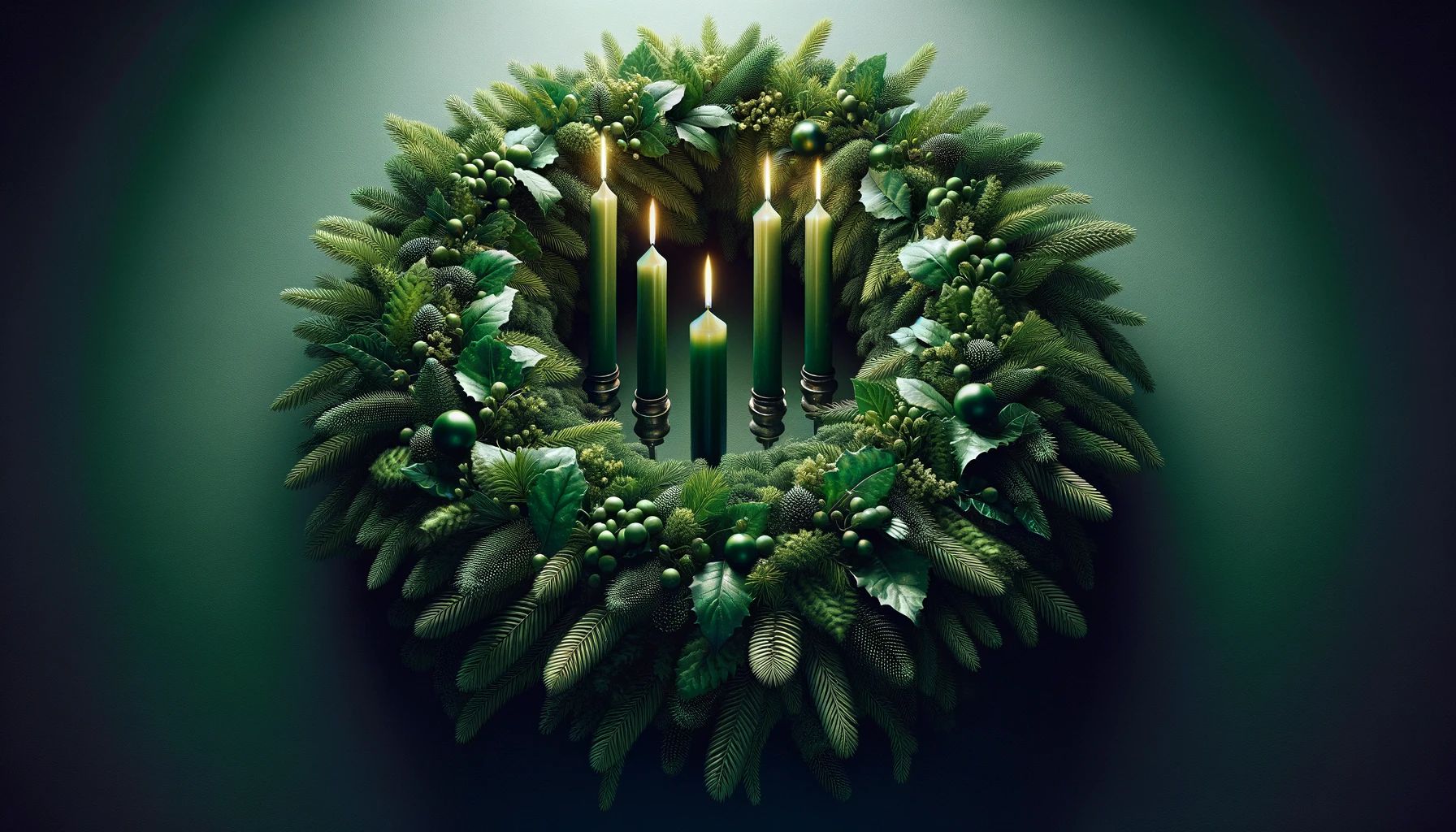Home>Special Themes>Why Is The Advent Wreath Green


Special Themes
Why Is The Advent Wreath Green
Published: February 14, 2024
Peter Smith, Editorial Director at Christian.net, combines deep insights into faith, politics, and culture to lead content creation that resonates widely. Awarded for his contributions to religious discourse, he previously headed a major organization for religious communicators, enhancing dialogue on faith's societal impacts.
Discover the significance of the green Advent wreath and its symbolism in the Christian tradition. Explore the special themes associated with the greenery and its spiritual meaning.
(Many of the links in this article redirect to a specific reviewed product. Your purchase of these products through affiliate links helps to generate commission for Christian.net, at no extra cost. Learn more)
Table of Contents
Introduction
The Advent season is a time of anticipation and preparation for the celebration of the birth of Jesus Christ. It is a period marked by various traditions and symbols that hold deep significance in Christian faith. One such symbol is the Advent wreath, a cherished emblem of the season's spiritual journey.
The Advent wreath, typically adorned with four candles and evergreen foliage, serves as a visual representation of the anticipation and hope associated with the coming of Christ. The use of greenery in the Advent wreath holds profound symbolism, reflecting the enduring life and everlasting hope found in the Christian faith.
In this article, we will delve into the symbolism of green in Christianity, explore the history of the Advent wreath, and unravel the significance of green within this cherished tradition. By understanding the rich symbolism and historical context of the Advent wreath, we can gain a deeper appreciation for its role in the spiritual observance of the Advent season.
The Symbolism of Green in Christianity
In Christianity, the color green holds profound symbolism, representing a spectrum of spiritual concepts deeply rooted in the faith. Green is often associated with life, growth, renewal, and hope, making it a fitting symbol within the context of Christian beliefs.
First and foremost, green symbolizes life and vitality. It serves as a reminder of the abundant life that is found in God and the everlasting nature of His love. In the Bible, green pastures are often referenced as places of nourishment and rest, evoking a sense of peace and spiritual sustenance. This imagery aligns with the Christian belief in God as the source of life and sustenance for the soul.
Furthermore, green is emblematic of growth and renewal. Just as plants and foliage experience cycles of growth, Christians view spiritual growth as an ongoing journey. The color green serves as a visual representation of this continual renewal and the potential for spiritual transformation. It embodies the idea of new beginnings and the promise of God's grace to bring about positive change in the lives of believers.
Additionally, green is associated with hope and the promise of eternal life. The evergreen nature of certain plants symbolizes enduring life, even in the midst of challenging seasons. This symbolism aligns with the Christian belief in the hope of eternal life through faith in Jesus Christ. The color green serves as a reminder of the unyielding hope that believers have in the promises of God, even in the face of adversity.
In the context of the Advent season, the symbolism of green takes on added significance. As Christians prepare to celebrate the birth of Jesus Christ, the color green in the Advent wreath represents the anticipation of new life and the hope brought by the arrival of the Savior. It serves as a visual reminder of the spiritual journey leading up to the joyous celebration of Christ's birth.
Overall, the symbolism of green in Christianity encompasses themes of life, growth, renewal, and hope, all of which are central to the Christian faith. The use of green in religious practices and traditions, including the adornment of the Advent wreath, serves as a powerful visual representation of these enduring spiritual truths.
The History of the Advent Wreath
The history of the Advent wreath can be traced back to pre-Christian Germanic and Scandinavian traditions, where the use of evergreen wreaths during the winter solstice symbolized hope in the midst of darkness. Over time, this tradition evolved within the context of Christian observances, eventually becoming intertwined with the Advent season.
The origins of the modern Advent wreath as a specifically Christian symbol can be attributed to 19th-century Germany. It is believed that Johann Hinrich Wichern, a Protestant pastor and educator, played a pivotal role in popularizing the use of the Advent wreath as a spiritual tool for the observance of Advent. In 1839, Wichern created a wooden ring with 20 small red and 4 large white candles. The smaller candles were lit on weekdays, while the larger candles were lit on Sundays, marking the progression of the Advent season.
The symbolism of the Advent wreath continued to evolve, and by the early 20th century, the wreath had become a widely recognized tradition in both Protestant and Catholic churches. The circular shape of the wreath came to symbolize the eternal nature of God and His unending love, while the evergreen foliage represented the enduring life found in Christ.
The Advent wreath also underwent a shift in its symbolism, with the four candles coming to represent the four weeks of Advent. Each candle is traditionally lit on a Sunday leading up to Christmas, with the lighting of the candles serving as a visual countdown to the celebration of Christ's birth.
Today, the Advent wreath holds a central place in the spiritual observance of Advent in Christian communities worldwide. It serves as a focal point for prayer, reflection, and anticipation, providing a tangible symbol of the journey toward the celebration of the Incarnation.
The rich history of the Advent wreath underscores its significance as a cherished tradition that unites believers in the shared anticipation of the coming of Christ. As the Advent season unfolds each year, the presence of the Advent wreath serves as a timeless reminder of the enduring hope and joy found in the birth of Jesus Christ.
The Significance of Green in the Advent Wreath
The use of greenery in the Advent wreath holds profound significance, serving as a visual representation of enduring life, renewal, and hope within the context of the Advent season. The incorporation of evergreen foliage, typically in the form of pine, holly, or fir, carries deep symbolic meaning that resonates with the spiritual journey leading up to the celebration of Christ's birth.
First and foremost, the evergreen nature of the foliage symbolizes the enduring life found in Christ. In the midst of the winter season, when nature appears dormant and lifeless, the presence of evergreen plants serves as a powerful reminder of the unyielding vitality and everlasting hope that believers find in their faith. The greenery in the Advent wreath reflects the eternal nature of God's love and the promise of new life that comes through the birth of Jesus Christ.
Furthermore, the color green within the Advent wreath embodies the concept of spiritual renewal. Just as the evergreen foliage experiences continual growth and renewal, Christians view the Advent season as a time of spiritual preparation and anticipation. The greenery serves as a visual representation of the ongoing renewal and transformation that takes place within the hearts of believers as they prepare to welcome the Savior into their lives and communities.
In addition, the use of green in the Advent wreath conveys the theme of hope. The vibrant green foliage symbolizes the promise of new beginnings and the anticipation of the joyous celebration of Christ's birth. As each week of Advent unfolds, the gradual lighting of the candles amidst the lush greenery serves as a poignant reminder of the increasing hope and anticipation leading up to the arrival of Christmas.
Moreover, the circular shape of the Advent wreath, adorned with greenery, represents the unending nature of God's love and the eternal hope found in the Christian faith. The continuous circle of the wreath symbolizes the everlasting nature of God's presence and the unbroken cycle of His love and grace, further reinforcing the significance of the greenery within this cherished symbol of the Advent season.
In essence, the significance of green in the Advent wreath extends beyond its visual appeal, encompassing profound spiritual symbolism that resonates deeply with the themes of enduring life, renewal, and hope central to the Christian faith. As believers engage in the timeless tradition of the Advent wreath, the presence of greenery serves as a tangible reminder of the enduring hope and joy found in the anticipation of the birth of Jesus Christ.
Conclusion
In conclusion, the Advent wreath, with its vibrant greenery and symbolic candles, stands as a powerful emblem of the spiritual journey leading up to the celebration of the birth of Jesus Christ. The significance of green within the Advent wreath extends far beyond its visual appeal, encapsulating profound spiritual symbolism that resonates deeply with the core tenets of the Christian faith.
The symbolism of green in Christianity, representing life, growth, renewal, and hope, finds a poignant expression within the context of the Advent wreath. As believers engage in the timeless tradition of the Advent wreath, the presence of greenery serves as a tangible reminder of the enduring hope and joy found in the anticipation of the birth of Jesus Christ.
Furthermore, the rich history of the Advent wreath, rooted in both pre-Christian traditions and 19th-century Christian observances, underscores its enduring significance as a cherished symbol of the Advent season. The evolution of the Advent wreath from its early origins to its widespread adoption in Christian communities worldwide speaks to its enduring relevance as a visual representation of the anticipation and hope associated with the coming of Christ.
The Advent wreath, with its circular shape and evergreen foliage, serves as a visual reminder of the eternal nature of God's love and the promise of new life found in the birth of Jesus Christ. As each candle is progressively lit during the weeks of Advent, the vibrant greenery surrounding the candles serves as a poignant symbol of the increasing hope and anticipation leading up to the joyous celebration of Christmas.
In essence, the Advent wreath, adorned with greenery, embodies the timeless themes of enduring life, renewal, and hope that lie at the heart of the Christian faith. As believers gather around the Advent wreath each year, the presence of greenery serves as a powerful visual representation of the enduring hope and joy found in the anticipation of the birth of Jesus Christ, uniting individuals and communities in a shared journey of faith and celebration.















